Care and cultivation of peppers in a greenhouse: step-by-step instructions for novice gardeners
Pepper (sweet and bitter) is distinguished by its whimsicality and warmth. The culture is not easy to grow in Russia, especially in regions with extreme weather conditions. Almost all varieties give the maximum yield in our country only in greenhouses.
About the basic rules for the care and cultivation of pepper in a greenhouse - read on.
The content of the article
The best peppers for greenhouses
Exceptionally cold-resistant varieties are suitable for open field cultivation in the central part of Russia. And here any kind of pepper can be grown in the greenhouse... The protected ground allows you to create optimal conditions for even the most fastidious crops.
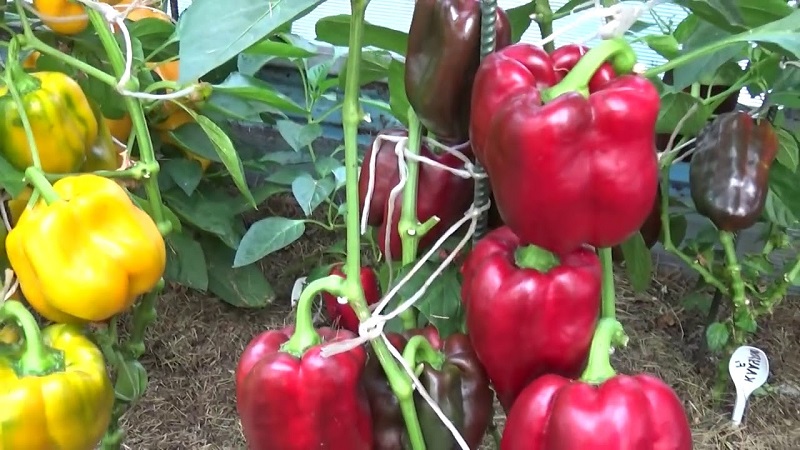
What varieties and hybrids most commonly grown in greenhouses and greenhouses:
- California miracle... The main feature is large-fruited. The mass of individual specimens reaches 500 g. The thickness of the walls is 12 mm.
- Black cardinal... Differs in an unusual dark purple fruit color. During the ripening period, they acquire a red tint. The bush reaches 1 m in height.
- Yova... Differs in high yield (up to 15 kg per 1 sq. M). Thick-walled Bulgarian pepper.
- Claudio... Mid-season. Dark red long fruits reach a weight of 250 g. It is immune to the main diseases of the nightshade. The bush reaches a height of 1.3 m.
- Atlant... The main feature is the short stature of the bush (up to 70 cm). Bulgarian pepper, thick walled and sweet taste.
- Denis... Early. The main stem grows in height no higher than 60 cm.The weight of each fruit reaches 300 g.
The described varieties give the best yield indicators. exactly in the greenhouse.
Features of growing pepper in a greenhouse
Agrotechnics of pepper in protected and open ground almost the same, but there are still several features of care in the greenhouse:
- The greenhouse maintains an optimal humidity level by regularly ventilating the room. Especially during the heat. It is necessary to create an ideal microclimate in the room.
- Pepper in the greenhouse is artificially pollinated. To do this, the bushes with inflorescences are shaken daily. This is done carefully so as not to damage the plant stems. An easier way is to put a fan in the greenhouse, which will promote both pollination and optimal air exchange.
- In the greenhouse, the beds are watered much less often. Usually, in such conditions, the pepper only needs one watering per week.
- Pepper is easily pollinated. Therefore, hot and sweet peppers are not planted in the same greenhouse. It is not recommended to place plants of different varieties next to each other, especially if you plan to use their fruits to collect seeds for planting.
Advice! Plants that require different growing conditions cannot be planted in the same greenhouse. For example, peppers and cucumbers.
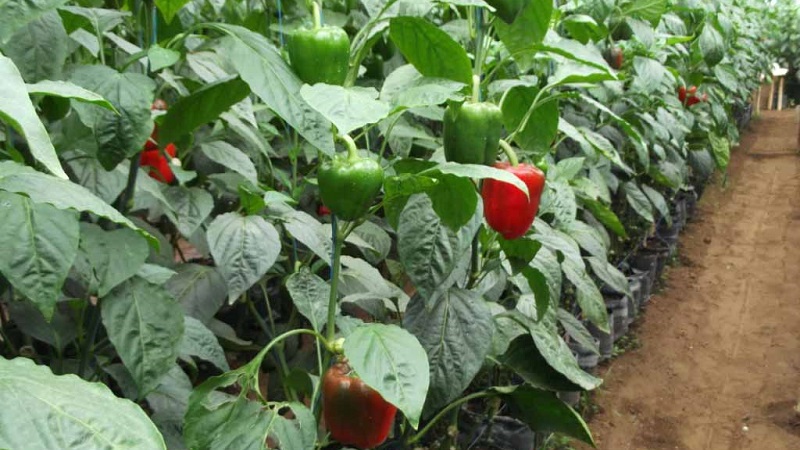
Landing
Some farmers cultivate greenhouse peppers all year round. In this case, you will need a fully equipped room. If the cultivation of the plant is planned only in the warm season, then lighter polycarbonate structures or greenhouses are also suitable.
Planting peppers in heated greenhouses is possible at any time of the year... In simpler shelters, the culture is planted in May.
If the greenhouse is not heated, peppers are grown exclusively in seedlings.... Otherwise, he simply will not have time to harvest before the cold snap.
Seed preparation
Pepper seeds, especially hybrid ones, are sold by many producers already processed.... They are pickled and coated with nutrients at the factory. Processing information is indicated on the packaging. These seeds are colored orange or green.
If the seeds have not been processed by the manufacturer or planting material collected from their own harvest is used, then it will have to be prepared at home.
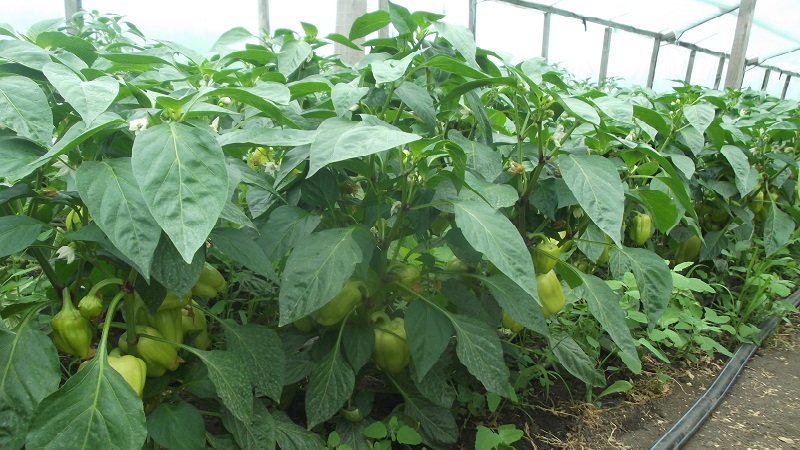
Step by step seed treatment:
- Calibration... The seeds are sorted out, leaving specimens with a uniform color without dark spots. They are soaked in salted water (1 tbsp. Water and 1 tsp. Salt). For planting, only planting material that has sunk to the bottom is suitable.
- Disinfection... The planting material is soaked in one of the means: for 30 minutes in a light pink solution of potassium permanganate, for 15 minutes in hydrogen peroxide, for 12 hours in a solution of soda (1 tsp for 1 tbsp. Of water) or for 12 hours in aloe juice ...
- Germination... The seeds are immersed for 12 hours in a growth stimulator ("Epin", aloe juice, "Zircon"). Then they are wrapped in cheesecloth and placed in a saucer with a sponge at the bottom. Seeds are watered with warm water, placed in a warm place and left until germination.
- Hardening... Pepper sprouts are refrigerated for 24 hours.
Seeds treated in this way will give the first shoots faster... Plants grown from them will have a high resistance to diseases and adverse environmental factors.
Growing seedlings
Pepper seedlings are grown directly in a heated greenhouse or pots... In the second case, the plants are stronger and more stocky, since it is easier to provide optimal conditions in a special room.
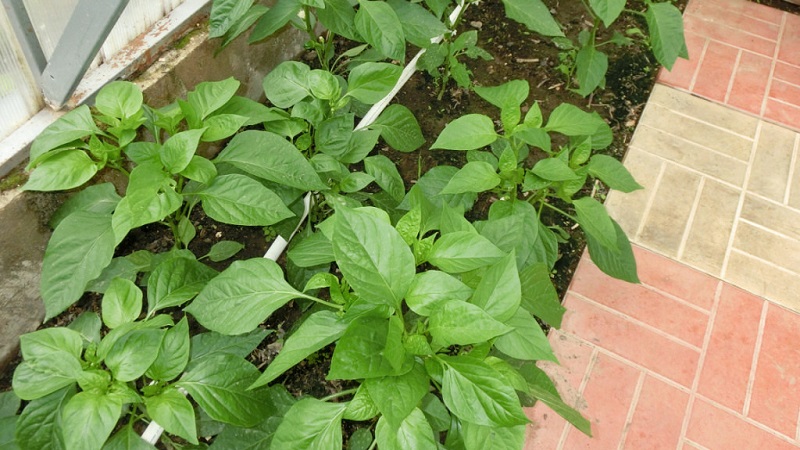
Seedling soil should be nutritious, but light... For its preparation, garden soil, humus and sawdust or sand are mixed in equal proportions. If the acidity of the resulting mixture is increased, then ash is added to it. Superphosphate is added for enrichment.
The soil must be disinfected. It is watered with hot copper sulfate or a dark pink solution of potassium permanganate. If the pepper is grown at home, then the earth is poured into pre-disinfected special boxes or peat pots.
Before sowing, the soil is watered with warm water... In it, grooves are made with a depth of 1-2 cm at a distance of 6 cm from each other. Seeds are sown at a distance of 1 cm from each other. They are covered with a film and kept at a temperature of 26-30 ° C until germination. When the planting material germinates, the film is removed.
Seedlings are watered as the topsoil dries.... Make sure that the water does not stagnate, otherwise the roots will begin to rot.
After 10 days, the weakest peppers are removed by breaking off their stem. After the appearance of two true leaves, the seedlings are thinned again in such a way that a distance of 5-6 cm remains free between the plants.
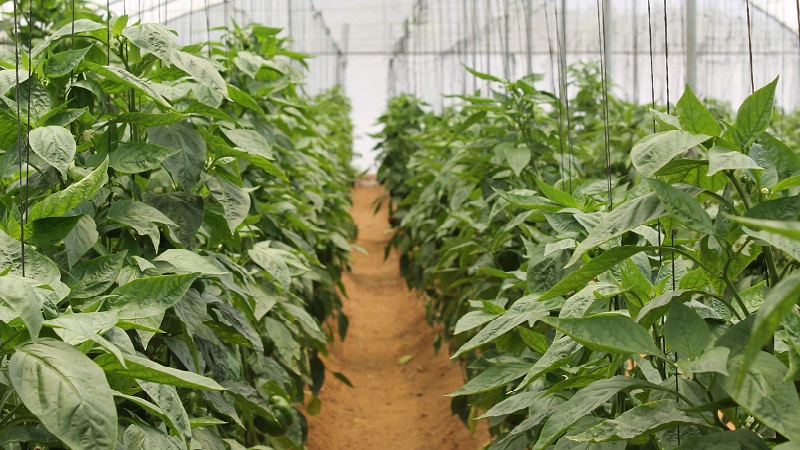
In winter, pepper will need additional lighting with fluorescent lamps.... If the seedlings are grown in spring, then natural light is enough for them.
For the entire growing period, seedlings are fed twice:
- Two weeks after the appearance of two true leaves, the first feeding is applied. Use a composition prepared from 5 liters of water, 3 g of urea and 15 g of superphosphate.
- The second time, fertilizers are applied five days before the pick. To prepare the nutritional composition, mix 5 liters of water, 25 g of superphosphate and 15 g of potassium sulfate.
Seedlings begin to grow 2.5 months before the pick plants to a permanent place.
Advice! If the plants are strong and stocky, have short internodes and bright green foliage, then the last dressing is not necessary.
Soil preparation and greenhouses
Before sowing seeds or planting seedlings in a greenhouse, it must be prepared. First of all, the room is cleaned of all plant residues and disinfected.... Not only the soil itself is watered with copper sulfate, the walls of the greenhouse are washed with it.
On the same soil, nightshades have not been grown for several years in a row. Greenhouses either change annually, or simply remove the topsoil every season, replacing it with a new one.
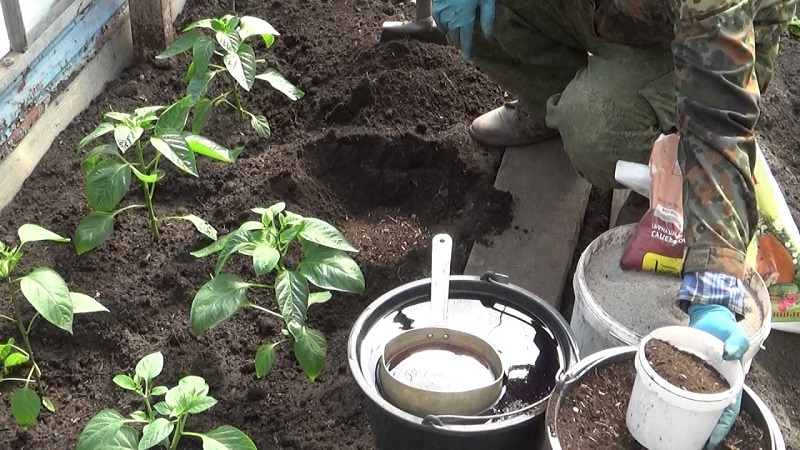
The soil must be enriched... For every 1 sq. m make 6 kg of rotted manure or humus. Also add 25 g of superphosphate and 15 g of urea.
Advice! Experienced vegetable growers sow the beds for the winter with rye. In spring, the plants that appear are dug up, mixed with soil and watered with "Baikal". Literally a month later, fertile soil is obtained at this place, which makes it possible to reduce the amount of necessary dressings.
Landing procedure
The planting scheme for pepper depends on its variety.... For 1 sq. m planted 3-4 bushes of tall plants and 4-5 bushes of low-growing specimens.
A handful of ash and granular long-acting complex fertilizers are added to the holes. Some gardeners add 1 liter of chicken manure diluted with water in a ratio of 1:10 to it.
Before boarding the seedlings are watered and carefully removed from the ground with a small spatula or fork, being careful not to damage the roots. Then they are placed in a hole, forming roots towards the center, and covered with soil, without deepening the root collar.
Landings watered warm water, spending at least 1 liter per plant. The next watering and feeding are possible not earlier than in two weeks.
Advice! Many farmers plant peppers in the greenhouse when two true leaves appear on the plants.
The timing of planting peppers in an unheated room depends on the climate of the region:
- southern (Belgorod, Sochi, etc.) - April;
- central (Moscow region, Tver, etc.) - early May;
- cities with a cooler climate (Siberia, Ural) - the second half of May.
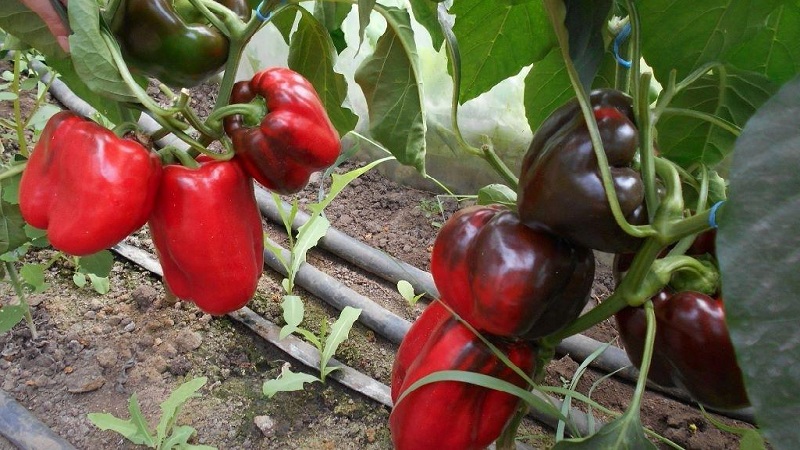
Greenhouse Pepper Care
To get a good harvest, it is important to properly care for the plantings. Here basic rules for growing peppersand:
- Pepper in the greenhouse is watered 1-2 times a week, spending 3-4 liters of warm water for each plant. Before flowering, the plants are watered by rain, then the liquid is poured only at the root. Moisture on the flowers will cause the pollen to clump. On the day of pinching and pinching, pepper is not watered.
- After each watering, the soil is loosened and cleaned of weeds. A layer of mulch in the beds (hay, straw, humus) will help to make these procedures more rare.
- Tall plants need to be pinched. This is done when the main stem reaches its maximum support height.
- Whether the pepper needs shaping depends on its variety. Low-growing varieties usually do not stepchild. Tall specimens form one or two stems. Sonkeeping is carried out early in the morning or late in the evening.
- Experienced summer residents recommend tying up all high-yielding varieties. Even undersized plants will break under the weight of the fruit if not tied up. The bushes are attached to the support with synthetic thread.
- Fertilize pepper 3-4 times per season. It is recommended to alternate 1:10 diluted chicken manure and complex mineral fertilizers. Before feeding, plants must be watered. The first time fertilizers are used two weeks after picking the seedlings to a permanent place.
- Greenhouses are regularly ventilated. This is especially important on hot days.
- To help pollinate the pepper, the bushes are shaken regularly.
Advice! Some vegetable growers use peppercorns for plant propagation.
Pepper care features by month
Peppers are grown in a greenhouse all year round... In August, July, May, June and September, the rules for caring for plants remain the same.
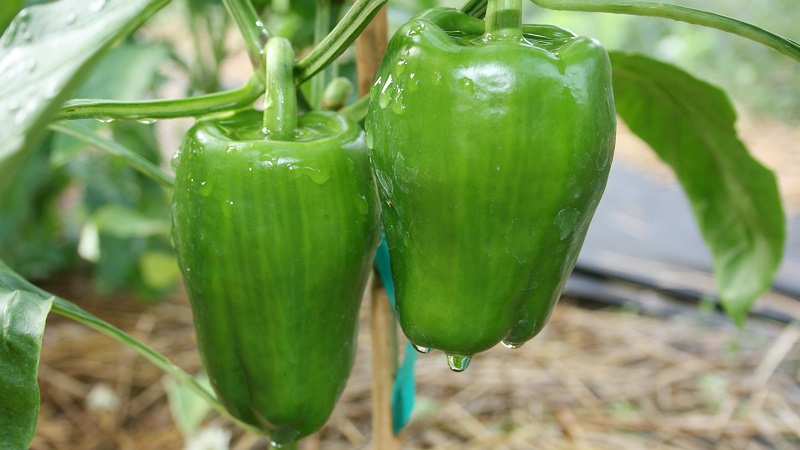
In colder months, plant care techniques will be different.... Here are the main nuances:
- In winter, the greenhouse is heated to maintain a comfortable room temperature.
- To reduce the risk of developing diseases, ensure correct air exchange in the greenhouse.The vents cannot be opened in winter, so it is important to take care of a good ventilation system.
- It is recommended to reduce the amount of watering in winter. Plants are watered only once a week.
Diseases and pests
In a greenhouse, diseases spread more easily between plants.... Here it is especially important to follow the rules of prevention, which consist in correct crop rotation, disinfection of tools and premises, proper watering and regular inspection of the bushes.
The most common diseases of pepper in the greenhouse:
- Pepper seedlings are damaged by a black leg. The stem begins to rot and darken at the base. Affected plants cannot be saved, they are removed. Healthy seedlings and beds are then treated with copper sulfate.
- Gray rot... Soft dark spots appear on the fruit. Affected fruits are removed. If the symptoms of the disease appear on the stems, then such areas are coated with "Rovral".
- White rot... Stems and leaves of plants are covered with soft spots with a white bloom. To cope with the problem, plantings are treated with copper sulfate.
- Verticillary and fusarium wilting... The leaves and stems of plants turn yellow, curl and wither. There is no cure. The main prevention is the disinfection of seeds and the observance of crop rotation.
- Late blight... All parts of the plant are covered with brown or dark brown spots. As a preventive measure, peppers are sprayed with Bordeaux liquid. There is no cure.
- White spot... The plants are covered with white dry spots with a dark border, which later develop black spores. This leads to wilting and death of the pepper. In the early stages of planting, they are rescued by spraying the beds with Fitosporin.
- Bacterial cancer... Brown spots form on the plants, which gradually merge with each other, become covered with a crust and lead to the death of the plants. There is no cure. Diseased plants are removed, and healthy plants are sprayed with copper sulfate.
Diseases are not the only threat to pepper... The danger is and pests... In greenhouses, the beds are most often attacked by whiteflies, thrips and aphid... To prevent the appearance of insects, the windows are covered with special nets. If the pests have already affected the bushes, the plants are sprayed with a solution of laundry soap or a decoction of wormwood.
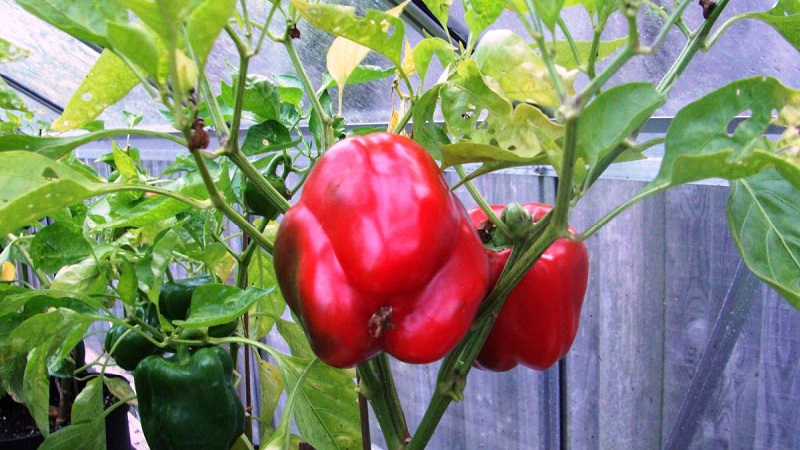
Harvesting and storage
The harvest of pepper depends on the time of planting and on the timing of ripening... They begin to collect it in July and finish in October.
Experienced growers recommend picking peppers as soon as they reach their maximum size. Such specimens will ripen at home, but will not interfere with the development of other fruits.
Store the crop in a cool, dry place... It is important to regularly sort out the fruits, removing all damaged ones.
The nuances of growing sweet and bitter peppers in a greenhouse
The rules for caring for sweet and bitter peppers do not differ... Both varieties need regular watering, feeding and protection from disease.
Most hot peppers do not require pinching... In addition, this variety is less susceptible to pests due to its pungent taste.
Important! Bell peppers and hot peppers are not planted in the same greenhouse. Otherwise, dusting will occur and sweet fruits will acquire a bitter taste.
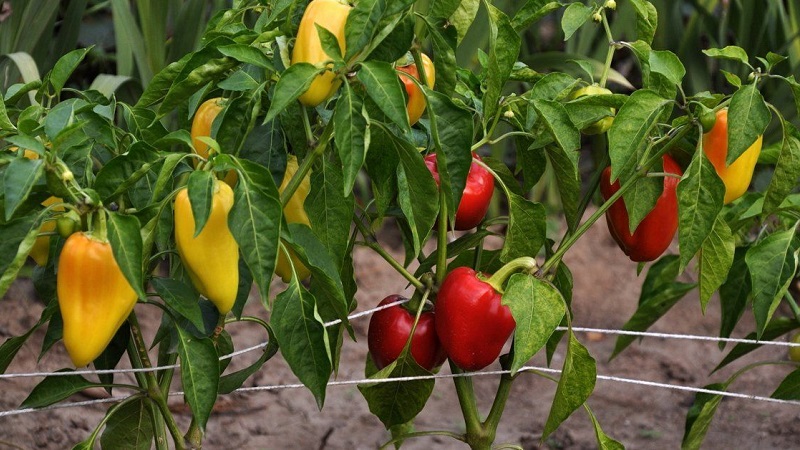
Growing peppers in a greenhouse as a business
Growing peppers in a greenhouse is becoming a lucrative business for many gardeners. there is several secrets that will allow you to get the maximum yield and reduce the cost:
- Harvesting at the stage of technical ripeness, when the fruits have reached their maximum size, but have not acquired a uniform color. This will increase the yield of the bushes and allow the product to last longer.
- The use of varieties, not hybrids. In this case, the seeds from the harvested crop will be suitable for sowing, and the vegetable grower will not have to spend annually on new planting material.
- Use of varieties with disease resistance.This minimizes crop losses due to disease and reduces the cost of chemicals.
Conclusion
Greenhouse structures allow you to grow pepper in any region of our country. If you provide heating and properly equip the premises, the harvest will become available all year round.
When cultivating pepper in a greenhouse, it is important to follow all the rules of agricultural technology and regularly inspect the bushes for diseases. Indeed, indoors, infections spread faster than in the fresh air.